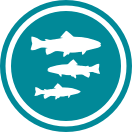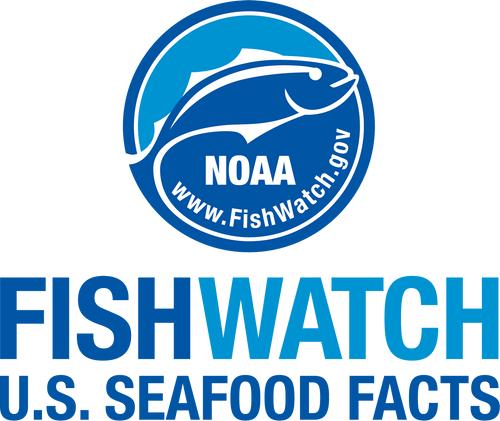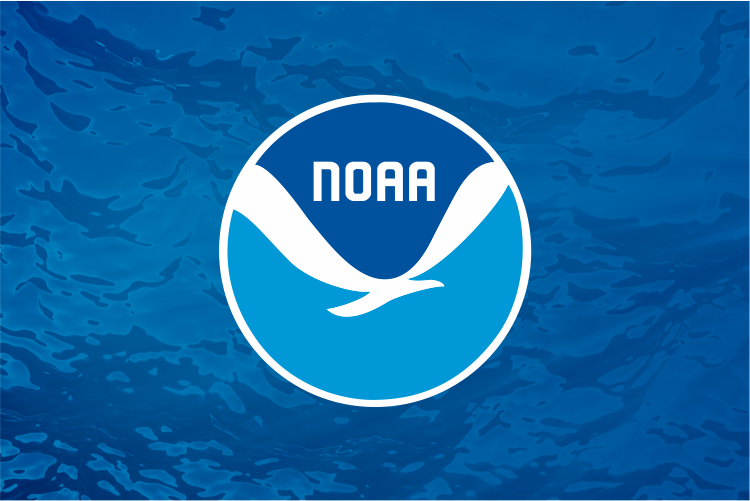About the Species
U.S. wild-caught Greenland turbot is a smart seafood choice because it is sustainably managed and responsibly harvested under U.S. regulations.

Population
The Bering Sea/Aleutian Islands stock is not overfished.

Fishing Rate
Not subject to overfishing.

Habitat Impact
Area closures and gear restrictions protect habitats affected by some types of fishing gear used to harvest Greenland turbot.

Bycatch
Regulations are in place to minimize bycatch.
Population Status
- There are two stocks of Greenland halibut: a Bering Sea/Aleutian Islands stock and one stock contained in the Gulf of Alaska Deepwater Flatfish Complex. According to the most recent stock assessments:
- The Bering Sea/Aleutian Islands stock is not overfished (2022 stock assessment) and not subject to overfishing based on 2022 catch data. Summary stock assessment information can be found on Stock SMART.
- The Gulf of Alaska Deepwater Flatfish Complex is not overfished (2019 stock assessment) and not subject to overfishing based on 2022 catch data. Greenland halibut is contained in the stock complex, but Dover sole is assessed and is the primary species in the complex. Summary stock assessment information can be found on Stock SMART.
Appearance
- A cousin of the Pacific halibut, Greenland turbot are a right-eyed flatfish.
- As they develop, their left eye migrates across the top of the skull toward the other eye on the right side.
- They are yellowish or grayish-brown on top and paler on their undersides.
- They have large mouths and large teeth.
Biology
- Greenland turbot grow quickly, can reach up to 25 pounds, and can live up to 21 years.
- Females are able to reproduce when they reach about 2 feet in length and 9 years old.
- They spawn in the winter in deep water near the ocean floor.
- When they spawn, females release about 60,000 to 80,000 eggs, and males fertilize them as they swim past.
- Once hatched, larvae drift hundreds of miles out of the deep ocean into shallower waters over the continental shelf to feed and grow.
- After a few years, larvae move back out to deeper waters over the continental slope.
- Greenland turbot feed on crustaceans, squid, and various fish.
- Narwhals, Pacific cod, and halibut prey on Greenland turbot.
Where They Live
Range
- Greenland turbot are found throughout the Bering Sea and Aleutian Islands and Gulf of Alaska regions in the North Pacific Ocean. They are less common in the Gulf of Alaska.
- They are also found in the Northwest Atlantic in cold Arctic waters and deep bays around Newfoundland, Labrador, Baffin Island, and the Gulf of St. Lawrence.
Habitat
- Greenland turbot live near the ocean floor.
- They prefer cold temperatures and soft, muddy ocean bottoms.
Fishery Management
- NOAA Fisheries and the North Pacific Fishery Management Council manage the Greenland turbot fishery.
- Managed separately but similarly under the Fishery Management Plans for Groundfish in the Gulf of Alaska and the Bering Sea/Aleutian Islands.
- Permits are required and the number of available permits is limited to control the amount of fishing.
- Managers determine how much turbot can be harvested and then set annual catch limits.
- Catch is monitored through record keeping, reporting requirements, and observer monitoring.
- Certain seasons and areas are closed to fishing due to habitat and other species considerations (e.g., king crab and Pacific halibut).
- In the Bering Sea, a percentage of the allowable catch is allocated to the community development quota program, which benefits fishery-dependent communities in western Alaska.
Harvest
- In 2022, commercial landings of Greenland turbot totaled 3 million pounds and were valued at $1.7 million, according to the NOAA Fisheries commercial fishing landings database. The majority of the catch comes from the Bering Sea/Aleutian Islands.
- Gear types, habitat impacts, and bycatch:
- Bottom trawls and longlines are used to harvest Greenland turbot.
- Turbot are harvested over sand and mud ocean bottoms, which are more resilient to impacts from fishing than other habitats.
- Longlines can incidentally catch seabirds and fish. Fishermen must use seabird avoidance devices, which help reduce seabird bycatch.
- Fishermen use circle hooks to increase survival of undersized halibut caught and released during commercial fishing.
- There are limits on the amount of halibut that groundfish fisheries can incidentally catch. If the limit is reached, managers close the fishery for the remainder of the season.
- A number of regulations, such as gear restrictions and closed areas, are used to prevent and reduce bycatch in the fishery.
- Greenland turbot are also harvested incidentally in fisheries targeting other groundfish, including arrowtooth flounder, sablefish, and Pacific cod.
Scientific Classification
| Kingdom | Animalia |
|---|---|
| Phylum | Chordata |
| Class | Actinopterygii |
| Order | Pleuronectiformes |
| Family | Pleuronectidae |
| Genus | Reinhardtius |
| Species | hippoglossoides |
Last updated by NOAA Fisheries on 09/09/2024
Featured News
 Offloading frozen Pacific cod from a catcher-processor vessel in Dutch Harbor, Alaska. Credit: NOAA Fisheries / Paul Hillman.
Offloading frozen Pacific cod from a catcher-processor vessel in Dutch Harbor, Alaska. Credit: NOAA Fisheries / Paul Hillman.
 Alaska pollock. Credit: NOAA Fisheries.
Alaska pollock. Credit: NOAA Fisheries.
Seafood Facts

Is Greenland Turbot Sustainable?
U.S. wild-caught Greenland turbot is a smart seafood choice because it is sustainably managed and responsibly harvested under U.S. regulations.
Availability
Year-round.
Source
U.S. wild-caught from Alaska.
Taste
Sweet, rich flavor that is similar to halibut.
Texture
Dense.
Color
White flesh.
Health Benefits
A healthy, low-fat source of protein that is high in omega-3 fatty acids.
Nutrition Facts
Servings: 1; Serving Weight: 100 g (raw); Calories: 186; Protein: 14.37 g; Total Fat: 13.84 g; Total Saturated Fatty Acids: 2.419 g; Carbohydrate: 0 g; Total Sugars: 0 g; Total Dietary Fiber: 0 g; Cholesterol: 46 mg; Selenium: 36.5 mcg; Sodium: 80 mgMore Information
Last updated by NOAA Fisheries on 09/09/2024
Seafood News
 Chef Tyler Hadfield’s Curried Skate Wings with Tomato-Masala Chutney
Chef Tyler Hadfield’s Curried Skate Wings with Tomato-Masala Chutney
 NOAA Fisheries, in collaboration with Blue Ocean Mariculture, is conducting a multi-year pilot study to evaluate observational methods and tools for studying Hawaiian monk seal behavior. Courtesy of Blue Ocean Mariculture
NOAA Fisheries, in collaboration with Blue Ocean Mariculture, is conducting a multi-year pilot study to evaluate observational methods and tools for studying Hawaiian monk seal behavior. Courtesy of Blue Ocean Mariculture
 Tonya Wick aboard a fishing vessel at sea in 1998. Photo courtesy of Tonya Wick
Tonya Wick aboard a fishing vessel at sea in 1998. Photo courtesy of Tonya Wick
 Fish on display at the market. Credit: Shutterstock
Fish on display at the market. Credit: Shutterstock
Documents
2018 Status of Alaska Marine Ecosystems Considerations - Eastern Bering Sea Report in Brief
The eastern Bering Sea was characterized by anomalously warm conditions in 2018. Over the northern…
Bering Sea/Aleutian Islands and Gulf of Alaska Harvest Specifications for 2006-2007: Environmental Assessment and Final Regulatory Flexibility Analysis
Environmental Assessment and Final Regulatory Flexibility Analysis of the Gulf of Alaska and Bering…
Data & Maps
2024 Gulf Of Alaska Ecosystem Status Report: In Brief
This assessment summarizes and synthesizes climate, biological, and fishing effects on the shelf…
Ecosystem Status Report 2024 Gulf of Alaska
This assessment summarizes and synthesizes climate, biological, and fishing effects on the shelf…
2024 Aleutian Islands Ecosystem Status Report: In Brief
This assessment summarizes and synthesizes historical climate and fishing effects on the shelf and…
Ecosystem Status Report 2024 Aleutian Islands
This assessment summarizes and synthesizes historical climate and fishing effects on the shelf and…
Research
2023 North Pacific Groundfish Stock Assessments
2023 North Pacific Groundfish Stock Assessment and Fishery Evaluation Reports for 2024 Fisheries
2022 North Pacific Groundfish Stock Assessments
2022 North Pacific Groundfish Stock Assessment and Fishery Evaluation Reports for 2023 Fisheries
North Pacific Groundfish Stock Assessments and Fishery Evaluation Reports
Alaska Groundfish Stock Assessments, Economic Status Reports, and Ecosystem Status Reports.
2021 North Pacific Groundfish Stock Assessments
2021 North Pacific Groundfish Stock Assessment and Fishery Evaluation Reports for 2022 Fisheries
Last updated by NOAA Fisheries on 09/09/2024







